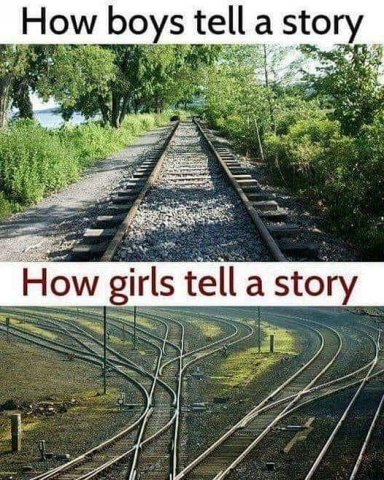You must not have heard me tell a story...
After a year of being on a forum in college, someone criticized a post of mine, saying I must have been trying to confuse the issue by bringing up all of this irrelevant information and if I had an actual, true point, I would be talking so much.
Someone else, who only knew me through the forum, somehwat defended me, in that he said, yes, Jon is confusing sometimes, but he means well, and you have to stick with the meandering until he gets to his point... :)
You bring up a point dear to my heart. I doubt we'd have the terrible "gender dysphoria" that plagues us today if our culture were not so determined that "THIS is what girls are like and THAT is what boys are like." Even in the "benighted 50's" I grew up able to enjoy what I enjoyed and think as I thought without those qualities implying that I "wasn't really a girl."
It is true, however, that the stories I hear indicate that the need to give the details and backstory instead of getting abruptly to the "point" are more common among women. Maybe I should add "and among men who see more in color variations than in black and white." :)
Are you familiar with Myers-Briggs typology? It's not the answer for everything, but it partly addresses a certain part of this storytelling difference.
MB has 4 different dichotomies, each with a choice of letters (I or E for Introvert vs Extrovert, and so on), to make a string that partially identifies some behaviors. Kind of like a row of seesaws at a playground. High Introvert, low Sensing, low Thinking, High Perceiving==ISTP, for example. Because any person doing the identifying has a bias towards a strong dichotomy (the Introvert one in this example), they can struggle with understanding people from the other extreme of that dichotomy.
My point on this is that P (Perception) tend towards the chaos of the second picture. Not always, but they are in stark contrast with the other end of their dichotomy, J (Judging), who treasure clear timelines.



